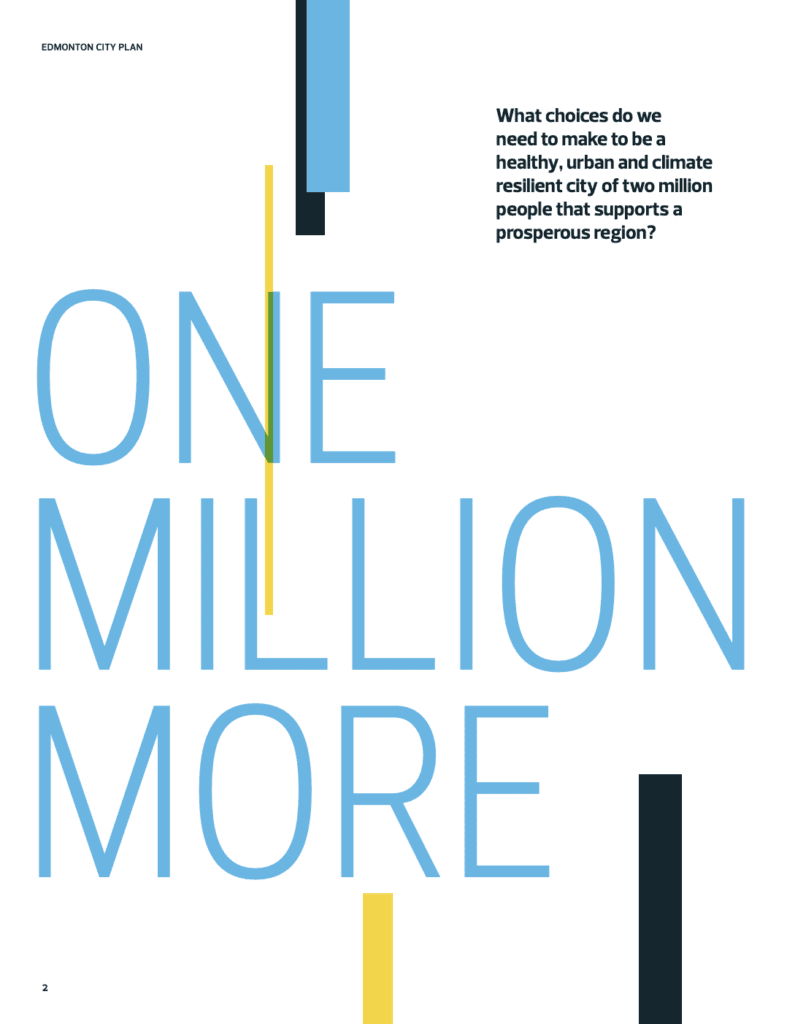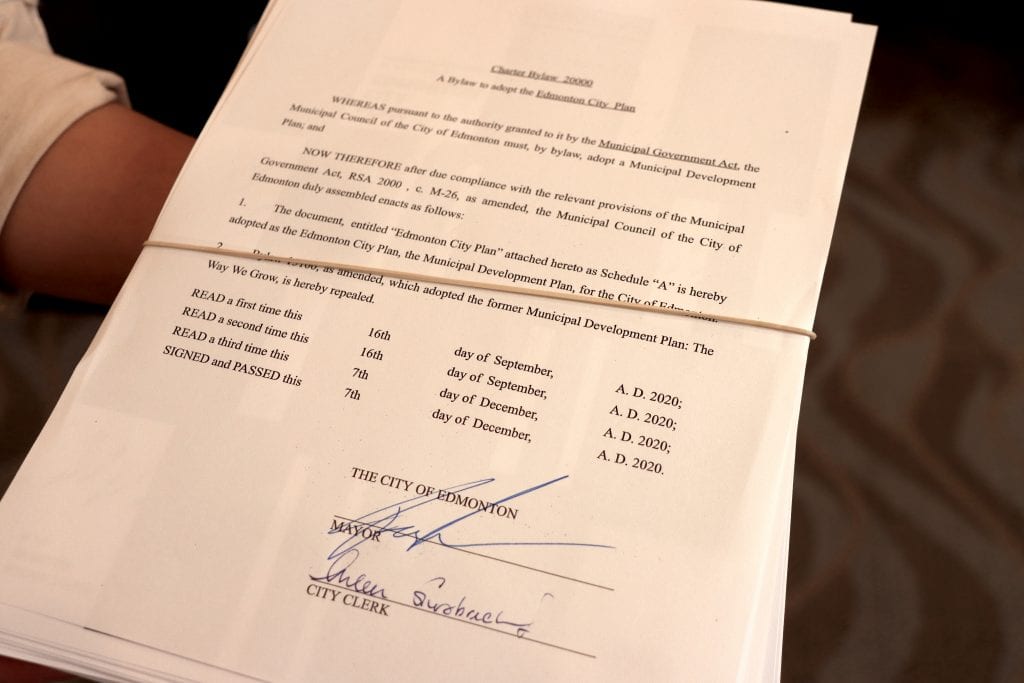The City Plan
A note to Edmontonians: this is one of the transition memos that I developed for the next Council. In making them public, I hope that they are of use to candidates and voters alike and contribute to a productive discussion about Edmonton’s future.
Edmonton is a city of 1,047,003 and we are well on our way to reaching 2 million. But how do we build a city that is ready for the next step? The City Plan is Edmonton’s vision, it’s our way forward to grow as a healthier, more urban, more climate resilient, and more prosperous place.
Planning is the most important tool that cities have. Planning can make a difference for economic prosperity and competitiveness, climate change, social inclusion, and quality of life. After years of engagement and policy development, this Council adopted the City Plan in December 2020. The next Council will have the opportunity to carry on its implementation.

Why
The City Plan is our guide to honouring the values that we heard from Edmontonians through extensive public engagement. It also lays the blueprint down to build an Edmonton that is connected and community-oriented. The City Plan’s six Guiding Values are the plan’s policy directions:
- I want to BELONG and contribute
- I want to LIVE in a place that feels like home
- I want opportunities to THRIVE
- I want more ACCESS within my city
- I want to PRESERVE what matters most
- I want to be able to CREATE and innovate
These directions represent the aspirations of Edmontonians and articulate the choices we need to make to become a healthier, more urban, climate-resilient city supportive of a prosperous region.
The City Plan combines a Municipal Development Plan and Transportation Master Plan, and includes strategic direction in environmental planning, social planning and economic development. It is intentional in its goals to drive growth to be more fiscally efficient for taxpayers, and also in its goal to build a city that is climate-resilient with lower GHG emissions and with a robust transit infrastructure.
While we are preparing to grow to 2 million, we need to do so sustainably; both environmentally and fiscally. The City Plan outlines how this is possible, but it’s up to the next Council to take these steps.

An essential part of the plan is the inclusion of the regional context to align our growth plan, density targets, priority growth areas, and agricultural land preservation.
Opportunities
The future Edmonton that the City Plan brings to life has already started to bud. Projects like the Economic Development Action Plan, the Community Energy Transition Strategy, and the Zoning Bylaw Renewal Initiative are the first steps.
The next council will have several key decisions in front of them:
- Zoning Bylaw Renewal
- City Planning Framework
- Continued Mass Transit Investment
- Growth Management Framework
- Attracting Investment on the LRT Line: Attracting business, developer and citizen support on Transit-Oriented Development locations.
Opportunity: fiscal efficiencies
Committing to the City Plan will mean that Council will have the opportunity to continue the progress we have made on building a more compact, financially efficient city. The City Plan calls for the next one million Edmontonians to be accommodated within our existing boundaries, which will mean upping our density and making the most out of our existing infrastructure instead of continuing to build more and more infrastructure as we sprawl outwards. This is a long-term proposal, with a projected savings of about 8% over the coming decades. However, committing to the City Plan vision through projects like the Zoning Bylaw Renewal can improve the City’s financial position in the short and medium terms as well by driving vibrant urban growth that adds significant value to the City tax base, while avoiding costly sprawl.
Opportunity: regional integration
The Regional Growth Plan was adopted in 2017, and contains density minimums, priority growth areas, and a Regional Evaluation Framework for compliance among the member municipalities. The higher density targets mean 250 quarter sections of land preserved — an area larger than Elk Island National Park. And $5 billion less in infrastructure (roads, pipes, sidewalks, fire stations, rec centres, etc) will be required while we accommodate the next several decades of growth. The plan will be updated in the next mandate and should not be eroded.
Challenges
The challenge with any bold vision is that you need continued commitment to actually implement it, sometimes at odds with the status quo or the path of least political resistance.
We have broad agreement on the City Plan with key stakeholders such as the development industry — the folks who actually build the kind of city we say we want. However, there is a risk of faltering on implementation and ending up with a watered-down version of what we committed to in the Plan. That is why it will be critical for Council to have a clear line of sight on all the implementation projects mentioned above.
One to highlight in particular is the new growth management framework — quite literally about where and how we direct new residential growth. Implementation in line with the City Plan would mean much less growth on City outskirts and more resources directed towards redeveloping areas, building up and in instead of out. There is a risk of “leapfrogging” the framework and approving new outward development out of line with the framework or before the framework is complete.
One key part of the growth management conversation is about cost allocation for the necessary City infrastructure: matching up the question of “who benefits?” to the question of “who pays?” and finding the right tool (property tax, user fees, development levies, etc) to allocate those costs. This is key to building a more financially sustainable city and avoiding subsidizing sprawl. Here, too, Council should be cautious about faltering on implementation.
Large-scale projects like the growth management framework and zoning bylaw renewal are key to City plan implementation, but implementation will also come down to many smaller rezoning decisions Council will consider at public hearings. The new Council will need to be familiar with the City Plan and ensure that every decision comes back around to supporting the vision that Edmontonians have put forward. My advice:
- Have the courage to support good projects
- Remember to have standards for quality
- Carefully consider the recommendations from the City’s planning staff and the Edmonton Design Committee.
Conclusion
For the first time in a long time, Edmonton has a plan, a truly forward-thinking vision. We have a plan for building our community and setting ourselves up for economic success and environmental sustainability.

The plan represents a significant shift from the status quo over time. That brings its own opportunities and challenges, but it is important to remember that we can’t stay the exact same. We can’t keep on growing unsustainably forever. The City Plan lays out the intentional choices we can make to grow as a more urban, more green, more healthy, and more prosperous place.
In most of the transition memos covering other topics, I tried to offer some helpful ‘big ideas’ to move those conversations forward. For the City Plan, though, I don’t think we need any more big ideas. That’s all in the Plan itself. The task at hand is dedicated follow-through and an intergenerational focus that will make sure Edmonton’s best days are ahead of us.
Key partners
- Urban Development Institute – Edmonton Region
- Canadian Homebuilders Association – Edmonton Region
- Edmonton Federation of Community Leagues
- Infill Development in Edmonton Association, IDEA
Further considerations
- Do you support Edmonton’s City Plan?
- Yes, and we should be going further?
- Where should we raise our aspirations?
Further Reading
Read other transition memos